- News
- Reviews
- Bikes
- Accessories
- Accessories - misc
- Computer mounts
- Bags
- Bar ends
- Bike bags & cases
- Bottle cages
- Bottles
- Cameras
- Car racks
- Child seats
- Computers
- Glasses
- GPS units
- Helmets
- Lights - front
- Lights - rear
- Lights - sets
- Locks
- Mirrors
- Mudguards
- Racks
- Pumps & CO2 inflators
- Puncture kits
- Reflectives
- Smart watches
- Stands and racks
- Trailers
- Clothing
- Components
- Bar tape & grips
- Bottom brackets
- Brake & gear cables
- Brake & STI levers
- Brake pads & spares
- Brakes
- Cassettes & freewheels
- Chains
- Chainsets & chainrings
- Derailleurs - front
- Derailleurs - rear
- Forks
- Gear levers & shifters
- Groupsets
- Handlebars & extensions
- Headsets
- Hubs
- Inner tubes
- Pedals
- Quick releases & skewers
- Saddles
- Seatposts
- Stems
- Wheels
- Tyres
- Health, fitness and nutrition
- Tools and workshop
- Miscellaneous
- Buyers Guides
- Features
- Forum
- Recommends
- Podcast
£3,199.00
VERDICT:
If you want a bike to do it all, then you should take a serious look at the Genesis Datum, a prime contender for bike of the year
Weight:
8,910g
Contact:
At road.cc every product is thoroughly tested for as long as it takes to get a proper insight into how well it works. Our reviewers are experienced cyclists that we trust to be objective. While we strive to ensure that opinions expressed are backed up by facts, reviews are by their nature an informed opinion, not a definitive verdict. We don't intentionally try to break anything (except locks) but we do try to look for weak points in any design. The overall score is not just an average of the other scores: it reflects both a product's function and value – with value determined by how a product compares with items of similar spec, quality, and price.
What the road.cc scores meanGood scores are more common than bad, because fortunately good products are more common than bad.
- Exceptional
- Excellent
- Very Good
- Good
- Quite good
- Average
- Not so good
- Poor
- Bad
- Appalling
The Genesis Datum joins a class occupied by the brilliant Cannondale Synapse and Giant Defy, but while both those bikes limit tyre size to 28mm – and lack mudguard eyelets – the Datum accommodates 33mm tyres and has mounts for full-length mudguards. Add a beautifully finished carbon fibre frame and fork, a slick shifting Shimano Ultegra Di2 drivetrain with hydraulic disc brakes, wonderful Challenge Strada Bianca tyres, and you have a hugely capable bike that is loads of fun over all sorts of terrain.
The Datum isn't available in the shops yet, but you can order it. Here's our exclusive first review, ahead of it arriving at a bike shop near you.
Find your nearest dealer here
Buy this online here

How does it ride?
Genesis has worked wonders with the geometry, and the result is a bike that has a very sure-footed approach, whether cruising along a smooth road or exploring gravel paths and singletrack.
If you don’t race and you like a slightly taller front end, you’ll be right at home on the Datum. Long rides are dispatched with ease. I was impressed with how comfortable it was during a 190km ride, during which the Datum revealed a quick turn of pace, with lively handling that makes it a fun bike to ride.

There’s never a dull moment on the Datum. There are few direct rivals but it most reminded me of the Giant Defy Advanced, a long-legged distance bike that also manages to have a playful personality.
It’s not a race bike, but the Datum is no slouch. The 30mm tyres fitted to this test bike display a slight hesitation in acceleration from low speeds, but it’s minimal really and once up to a decent speed they roll along with impressive ease. Any concerns that they would be draggy and slow compared with a narrower tyre soon faded as the miles racked up, and the more I rode them, the more I was won over. Comfortable, smooth, loads of grip and not at all slow. Just wonderful.

The ride of the Datum is quite firm; it doesn’t exactly cosset you from the road surface, but with around 80psi in the tyres they soak up the most cracked and potholed roads sufficiently. The tyres’ high level of grip also increases confidence on badly surfaced roads in poor conditions, with none of that skittish behaviour typical of a race bike on skinnier rubber.
Check out our buyer's guide to the best road cycling tyres here
With the Datum’s huge frame and fork clearance around the tyres – and space for proper full-length mudguards, a bonus for winter riding – you can really entertain any desire to head away from congested roads and onto gravel paths, bridleways and woodland singletrack, with little fear of clogging or sharp objects being squeezed between tyre and frame.

Having said that, even though the Challenge tyres are capable of withstanding some rough riding, if I was going to be spending more time exploring off-road trails I’d prefer a tubeless setup.
But it’s on the road that the Datum really excites and entertains. Despite the tall front end and big tyres it’s still a sporty bike and indulges any desire to ride at speed. The steering is quite light and direct, and the hydraulic disc brakes give you a level of control that conventional brakes can’t match, especially in the wet.

The stiff front end provides sharp cornering accuracy, and the steering feel and easily accessible drops (because of the longer fork) make it a natural in the turns. Add in the huge traction from the tyres and this is a bike that’s very much at home on the descents, especially on poorly surfaced and wet roads where it is outstanding. It climbs well too, considering its weight, which at 8.91kg really isn’t that bad for this sort of bike.
The Datum is simply a really nice riding carbon fibre road bike in the endurance/sportive mould, and it just happens to take bigger tyres than just about any other bike in its class. It can handle anything you throw at it (I even fitted some cyclo-cross tyres) and delivers plenty of performance.
Few bikes deliver such a complete package as the Datum: it’s fast and fun enough for summer riding and ready for the winter with mudguards and disc brakes.

The frame: Carbon fibre, thru-axle fork and mudguard mounts
The Datum, from a company once best known for producing steel, aluminium and titanium frames well suited to UK riding conditions and styles, is Genesis’s second carbon fibre offering, following hot on the heels of the Zero race bike, developed for the Madison-Genesis race team. It might upset a few traditional Genesis fans, but the use of carbon fibre has provided the freedom necessary to create the Datum.

Road bikes have been evolving quite rapidly in a few short years. Models like the aforementioned Synapse and Defy have proved popular with British cyclists seeking a bit more comfort from wider tyres and a frame geometry that is a little less aggressive than an out-and-out race bike.
The recent gravel and adventure bike trend has also been raising eyebrows and increasing the appetite for even wider tyres and bikes with the ability to head into the wilderness – you only need look at the growing popularity of events like the TransContinental to see how people’s attitudes to riding and bikes is changing.
Possibly because of all this, it’s easy to get hung up on trying to categorise bikes. The Datum, though, is simply a carbon fibre road with disc brakes and big tyres. It’s at home on the road, with long distance comfort aplenty. It’ll tackle gravel paths, bridleways and even singletrack if you’re that way inclined.

It’s built along similar lines to the Synapse and Defy. They’re both popular bikes, but I know that many dislike the lack of mudguard mounts, and that for some, a 28mm tyre just isn’t wide enough anymore. The Datum, with its massively increased tyre capacity and ability to fit proper, full-length mudguards front and rear, is, in a way, the natural evolution of those endurance and sportive bikes, with no drawbacks or compromises.
Its carbon fibre frame is bristling with modern details. There’s a BB86 press-fit bottom bracket, tapered head tube, and fully internal gear and brake routing, with the rear brake hose passing through the down tube. The top tube slopes dramatically, providing good standover clearance, and meets a 27.2mm-diameter seatpost. A detail that will satisfy any adventure or bikepacking cyclists is the addition of a third bottle cage mount on the down tube.
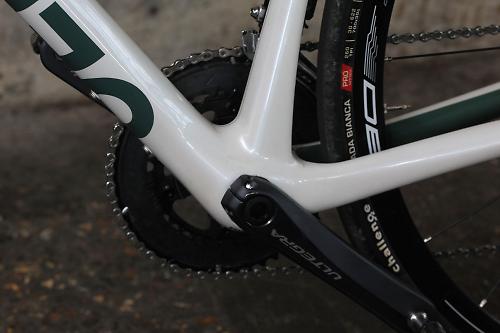
To provide the necessary tyre clearance in the rear of the frame, Genesis has curved the seat tube around the rear wheel. It’s the sort of thing you typically see on a race bike shaped in a wind tunnel, but there’s no aero consideration here, it’s purely a smart way of keeping the chainstays short (420mm) while still providing space for the big tyres. The curved seat tube should provide a smidgen more deflection as well, reckons Genesis.
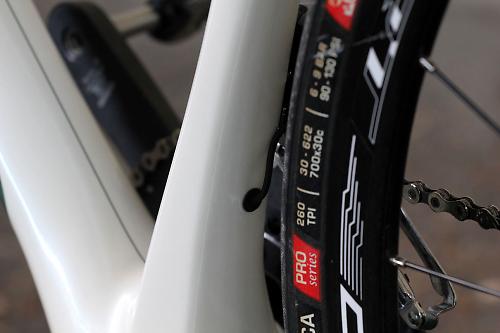
Up front Genesis uses a carbon fibre fork with a 15mm bolt-thru axle (the axle fits through holes in the fork dropouts rather than slotting in). Its 397mm axle-to-crown measurement is typical of what you’d get on a cyclo-cross bike, and is necessary to provide the tyre clearance.
To offset its length, the head tube is short, just 155mm on the 56cm (medium) model tested. The crown has a squared off shape to maximise space between the tyre and fork, especially when a mudguard is fitted. The hydraulic hose is routed inside the fork, and there are flat mounts – replicated on the frame with a chainstay disc mount.

The geometry shapes up with a 72-degree head angle that, along with a 50mm offset fork, produces 59mm of trail, which Genesis reckons provides agility without sacrificing stability and maintains a healthy toe-clearance.
Other measurements for our medium frame are: a 561mm top tube, 1,017mm wheelbase, and 385mm reach and 585mm stack (the horizontal and vertical measurements from the centre of the bottom bracket to the top of the head tube).

Build: Electronic shifting and hydraulic disc brakes
Genesis is offering the Datum in three builds: the Datum 10 (£1,799) equipped with Shimano Tiagra and TRP HyRd disc brakes; the Datum 20 (£2,099), which steps up to Shimano 105; and the range-topping Datum 30 (£3,199) tested here, which packs a Shimano Ultegra Di2 groupset.
It goes without saying that the Ultegra Di2 groupset shifts perfectly, with whisper-quiet gear changes at the lightest touch of a button. It’s very easy to use. The brake levers operate Shimano hydraulic brakes, providing bountiful power with all the modulation you need to really make the most of the available stopping power. I didn’t lock a tyre once during testing, in the dry or rain, and experienced no brake rub or untoward noise.

The brakes are Shimano’s latest RS805 Flat Mount model, paired with 160mm rotors front and rear. The delivery of power and lever feel is identical to the previously tested Shimano BR-R785 hydraulic brakes, but the new callipers provide a much cleaner appearance on the fork and chainstay. The brake pads have cooling heatsink fins to help dissipate heat during prolonged use.

A compact 50/34 chainset is paired with an 11-32 cassette, which ensures you’re able to scale any climb, and is a boon if you’ve decided to load the bike with some bikepacking bags or kit for a multi-day adventure.

The Datum rolls on new Fulcrum Racing Sport DB CX wheels, and production bikes will ship with 33mm Strada Bianca tyres – the test bike was fitted with a 30mm version of the top-tier tyre with a higher (read more expensive) TPI.
The rest of the kit is Genesis own-brand stuff: aluminium handlebar (a new Randox flared drop model on production bikes), aluminium stem, seatpost and saddle. It’s all satisfactory componentry, adequate rather than exciting. I’d look at replacing the aluminium seatpost with a carbon fibre post to get a bit more rear end comfort.
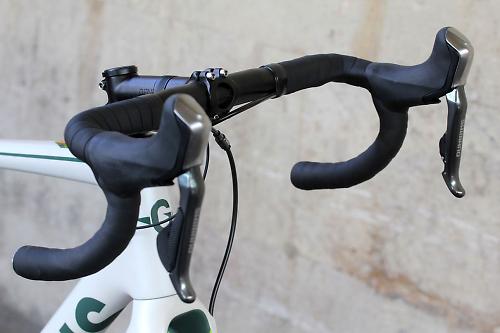
How does it compare against its rivals?
For a bike with similar tyre clearance and mudguard compatibility, you have to look away from the endurance and sportive category (where 28mm tyres are commonly the widest choice) and instead investigate the growing gravel and adventure class.
The most prominent rival is the GT Grade, a bike available in carbon or aluminium with similar tyre (it’ll take 35mm tyres) and mudguard compatibility.
Check out our buyer's guide to gravel and adventure bikes here
But another interesting choice occupying similar territory is the excellent Jamis Renegade. Its carbon frame is equipped with disc brakes and space for up to 40mm tyres, along with a full complement of rack and mudguard mounts. It also has a 15mm thru-axle fork. And it’s a bit of bargain, with prices from £1,400 up to £2,500.
A new option, which we’ve only had a first ride on so far, is the Felt V Series. Like the GT Grade it comes in aluminium or carbon fibre and the frame will accept up to 40mm tyres – it ships with either 28 or 32mm tyres – and there are also rack and mudguard eyelets for that year-round versatility.
Verdict
If you want a bike to do it all, then you should take a serious look at the Genesis Datum, a prime contender for bike of the year
road.cc test report
Make and model: Genesis Datum 30
Size tested: 56
About the bike
State the frame and fork material and method of construction. List the components used to build up the bike.
The Datum is an all-new model for 2016 and one that fits right in with the ethos of Genesis as a brand. Datum is a disc-braked carbon road bike range, with large (nay, huge!) tyre clearances. Don't necessarily think of Datum as a gravel bike, more a comfy, fast road bike with a more versatile twist.
Tell us what the bike is for, and who it's aimed at. What do the manufacturers say about it? How does that compare to your own feelings about the bike?
Frame : 24/30T Monocoque Carbon Road Disc w/ Tapered Headtube & Fully Internal Cable Routing
Fork : Full Carbon Fork w/ 1-1/2' – 1-1/8' Tapered Steerer & Ø15mm Thru-Axle
Headset : FSA Orbit C-40 / No.42 Integrated
Shifters : Shimano ST-RS785 Di2
Rear derailleur : Shimano Ultegra Di2 RD-6780-GS
Front derailleur : Shimano Ultegra Di2 FD-6870
Chainset : Shimano Ultegra FC-6800, 50/34T
Bottom Bracket : Shimano BB-RS500, Press-fit 86.5mm
Chain : KMC X11
Cassette / Freewheel : Shimano CS-5800, 11-32T, 11sp
Wheelset : Fulcrum Racing Sport DB CX
Tyres : Challenge Strada Bianca, 700–33c, 60TPI, Folding
Brakes : Shimano BR-RS805 w/ SM-RT86 160mm Icetech Rotors
Brake Levers : w/ Shimano ST-RS785 Di2
Handlebars : Genesis RandoX Flared (D125 x R70mm)
Grips / Tape : Genesis PU Shockproof Anti-Slip
Stem : Genesis Road, +/-7°
Saddle : Genesis Road
Seatpost : Genesis Road, Ø27.2 – 350mm
Frame and fork
Overall rating for frame and fork
9/10
Tell us about the build quality and finish of the frame and fork?
Excellent build quality and attention to detail.
Tell us about the materials used in the frame and fork?
Full carbon fibre construction with a tapered head tube and bolt-thru axle fork, with internal cable routing.
Tell us about the geometry of the frame and fork?
Loosely based on the popular Equilibrium, the new Datum has a higher front end and sloping top tube.
How was the bike in terms of height and reach? How did it compare to other bikes of the same stated size?
Almost spot on - I just changed the stem for a longer one.
Riding the bike
Was the bike comfortable to ride? Tell us how you felt about the ride quality.
The big volume tyres provide a big boost in comfort over narrower tyres.
Did the bike feel stiff in the right places? Did any part of the bike feel too stiff or too flexible?
A very stiff front end gives the bike a very direct and communicative feel.
How did the bike transfer power? Did it feel efficient?
No flex from the frame when you push hard on the pedals.
Was there any toe-clip overlap with the front wheel? If so, was it a problem?
No
How would you describe the steering? Was it lively, neutral or unresponsive? Light and lively.
Tell us some more about the handling. How did the bike feel overall? Did it do particular things well or badly?
Despite the tall front end and big tyres, it's still a sporty bike and indulges any desire to ride at speed.
Which components had the most effect (good or bad) on the bike's comfort? would you recommend any changes?
The electronic shifters are a joy to use and the hydraulic disc brakes provide a braking performance that is far improved over conventional calliper rim brakes.
Which components had the most effect (good or bad) on the bike's stiffness? would you recommend any changes?
I'd look to change the seatpost for a carbon fibre one to provide a bit more deflection/comfort at the rear.
Which components had the most effect (good or bad) on the bike's efficiency? would you recommend any changes?
The big volume tyres are impressively smooth and comfortable and not at all slow.
Rate the bike for efficiency of power transfer:
9/10
Rate the bike for acceleration:
8/10
Rate the bike for sprinting:
7/10
Rate the bike for high speed stability:
9/10
Rate the bike for cruising speed stability:
8/10
Rate the bike for low speed stability:
9/10
Rate the bike for flat cornering:
8/10
Rate the bike for cornering on descents:
9/10
Rate the bike for climbing:
7/10
The drivetrain
Rate the drivetrain for performance:
10/10
Rate the drivetrain for durability:
8/10
Rate the drivetrain for weight:
7/10
Rate the drivetrain for value:
8/10
Wheels and tyres
Rate the wheels and tyres for performance:
8/10
Rate the wheels and tyres for durability:
8/10
Rate the wheels and tyres for weight:
8/10
Rate the wheels and tyres for comfort:
8/10
Rate the wheels and tyres for value:
8/10
Controls
Rate the controls for performance:
8/10
Rate the controls for durability:
9/10
Rate the controls for weight:
7/10
Rate the controls for comfort:
8/10
Rate the controls for value:
8/10
Your summary
Did you enjoy riding the bike? Yes
Would you consider buying the bike? Yes
Would you recommend the bike to a friend? Yes
Rate the bike overall for performance:
9/10
Rate the bike overall for value:
8/10
Use this box to explain your score
The Datum just does everything so well. It's fast and fun enough for a summer distance bike, the disc brakes and full mudguard mounts will make it an ideal winter bike choice, and you could even fit cyclo-cross tyres for more adventurous riding.
About the tester
Age: 31 Height: 180 Weight: 67kg
I usually ride: My best bike is:
I've been riding for: 10-20 years I ride: Every day I would class myself as: Expert
I regularly do the following types of riding: road racing, time trialling, cyclo-cross, commuting, touring, mountain biking
David worked on the road.cc tech team from 2012-2020. Previously he was editor of Bikemagic.com and before that staff writer at RCUK. He's a seasoned cyclist of all disciplines, from road to mountain biking, touring to cyclo-cross, he only wishes he had time to ride them all. He's mildly competitive, though he'll never admit it, and is a frequent road racer but is too lazy to do really well. He currently resides in the Cotswolds, and you can now find him over on his own YouTube channel David Arthur - Just Ride Bikes.
Latest Comments
- Gbjbanjs 9 min 6 sec ago
As an Irish person, I am embarrassed for this guy and the judge. He is clearly a thug, so do not get where he takes pride in wearing the country...
- ktache 15 min 17 sec ago
I don't think the fine toilet roll holder is made of an old chainset, looks more like the two biggest rings on a carrier from a cassette, my 9...
- Zazz53 46 min 45 sec ago
TBF there are plenty of mountain, gravel, Lime bikes and e-bikes using the Tamsin Trail. Have never seen a collision but have thought a number of...
- Rendel Harris 2 hours 20 min ago
Far be it from me to tell you your business, but if you want to promote your product sneakily on a website without paying for advertising then...
- JMcL_Ireland 4 hours 23 min ago
I absolutely stand by my criticism of Elite (note: I'm not criticising the volunteer marshals). They charge an arm and a leg for these events but...
- Destroyer666 4 hours 37 min ago
There's a lot of good stuff here, but shoe reviews are still lagging on average when comparing to for example bike or tire reviews. Specs relating...
- galibiervelo 5 hours 9 min ago
Loved the Bastion in the flesh but Lemond's bike has the soul. Nice event and met some friends and contacts but like the magazine, it does promote...
- Hirsute 7 hours 20 min ago
All in the article - road tax.
- chrisonabike 8 hours 34 min ago
Ah, but: in UK, if a motorist drives into you (or simply parks in a cycle lane, forcing you out into the path of another motorist) then the council...






































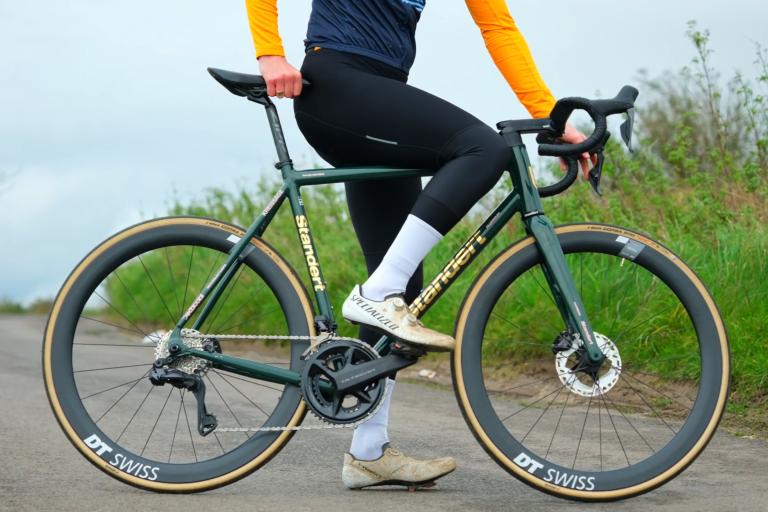
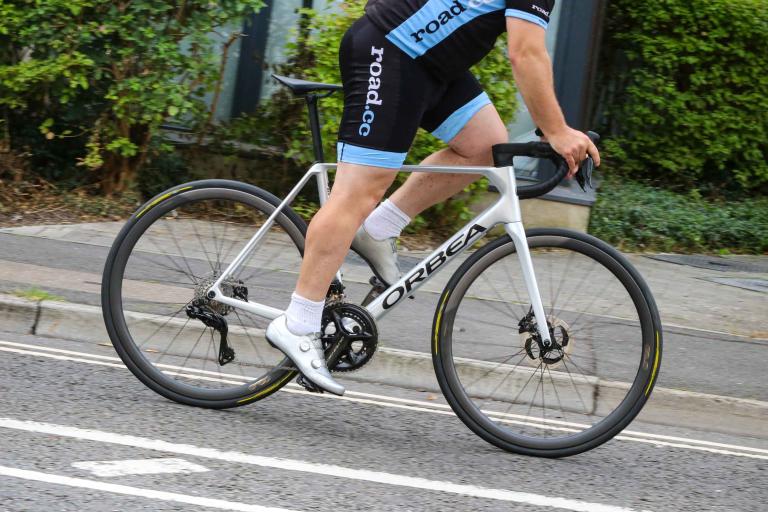
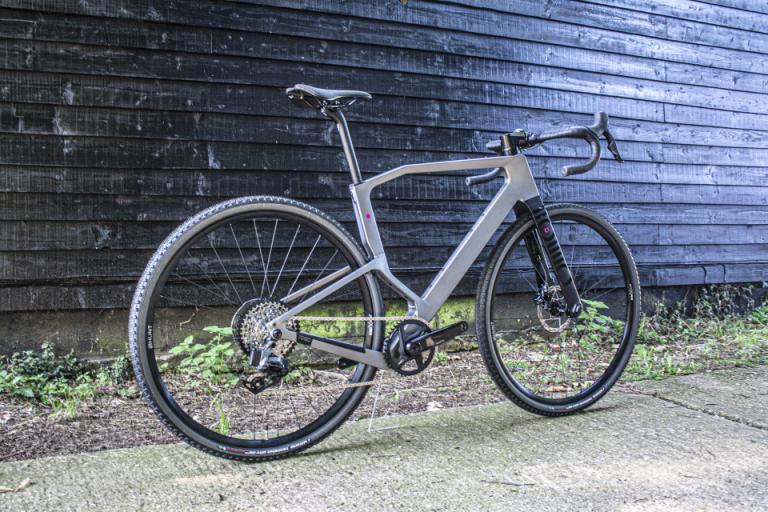
Add new comment
33 comments
FWIW - I have one of these earlier Datums and I run 38c Gravel Kings on it and it's a blast. Clearance ok for dry conditions but for UK mud I would go down to 33/35s. In road format I run it with 28s or 32s and guards. Still a good bike, consistently find myself riding it about 80% of the time. Epping Forest, check, PBP, check,, club runs, check, posh commuter, check. It's not an adventure bike but for anything between out and out racing and that it's a winner. I never thought I would warm to carbon but this bike has relegated my more 'comfortable' steel distance bikes becuase it is comfy enough while being a lot more fun, steering is brilliantly accurate and the climbing is so much better with those tucked-in carbon stays.
I like this bike, but can anyone explain how it is £3200???
Seriously even at RRP
Frame £1k
Wheels £150
Groupset £1k
Finishing kit £500 (maximum)
Still £500 short.
Groupset is more like £1560 rrp so there's your missing £500 straight away.
I know. It's mental. And it's pretty heavy. Canyon are doing this for £1099. It weighs the same - is built for the same kind of job and I seriously doubt there's 2 grand difference in them. And it's not black! Whoop!
https://www.canyon.com/en-gb/road/inflite/2016/inflite-al-8-0-s.html
Wow, I tried 28mm GP4000s on the stock RS11 wheels in my carbon Synpase, they cleared the frame (didn't look like 8mm though...) and spun freely but I started noticing some worrying scuffing on the tyre sidewall! Never figured out how it was happening but it was enough to put me off using the tyres...
The Datum may well be ready to take full size mudguards, but will the 105 and Ultegra equipped models actually be able to without having to resort to skinny tyres? The front mech for said group sets has serious clearance issues which I doubt Genesis have considered as far as full size mudguards are concerned.
33.3c Rivedell Jack Browns + 45mm mudguards + 105 longarm FD all playing nicely on my Datum custom build with room to spare.
Only the black model available as a frame-only option? Disappointing. One of Genesis' selling points are their gorgeous paint jobs. If I wanted black I'd get a Canyon.
Gorgeous maybe, but not very durable or hard-wearing if the CDF 30 and frame set paint jobs are anything to go by
I've had three Genesis bikes over the last few years and it's true, the paint is not always as tough as expected. My Aether was awful, a single thin coat of fragile paint that chipped as soon as you looked at it. My Equilibrium is considerably better but has still collected half-a-dozen chips despite leading a charmed and cosseted life.
The Croix de Fer, by contrast, survives all the knocks and scrapes of daily use without suffering any damage.
You will notice that such minor defects don't stop me buying them, they are all lovely bikes.
Yep same here, though I did go for a Croix de Fer 20 which has a better quality paint finish than the 30 and the frame set.
Fair point. My girlfriend actually has a CdF frameset in burnt bronze, this year's model, and it looked great for about 2 weeks until she actually rode it. Gets chipped just looking at it. My Kinesis, built at the same time, still looks as good as new.
Disc brakes: Check.
Di2: Check.
Genesis: Check.
This has sailed to number one in my next bike list.
I'm enjoying my Defy Advanced disc bike as my "wet bike". Aside from the fact that the (mechanical) discs are as good in the wet as they are in the dry (about as good as decent, but not great rim brakes) there is an additional benefit that wasn't immediately apparent. Because there are no calliper brakes and therefore no brake bridge either, and because all of the cables (brake and gear) are all internally routed, it is really easy to clean! Its surprising how much easier and quicker it is to do a quick wipe down on this bike after a wet ride than my previous non-disc, externally cable routed bikes (plus there is less cable maintenance required as well). I would add that although the Defy Advanced doesn't have mudguard eyelets (which is frustrating) I have found that you can fit SKS race blade clip-ons ok which I hope will be good enough when wet turns to muddy. No protection down the back of the seat tube of course, but I have that section from a Crud clip-on set which I might use as well if it starts to bother me.
That's a really good demonstration of how nice the flat mount calipers look on a bike designed for them Without rim brakes and the disc calipers being quite discreet, the frame looks very tidy.
Couldn't ride a bike that reminds me of Phil Collins all the time.
Looks like another winner for Genesis, especially with the cheaper models. Not sure the wife would approve of £3000+ for a bike, which explains why the CdA 10 is my workhorse.
Largely depends on rim used also (e.g. Conti 28c on a 19mm int. rim measure up 30mm)
The Synapse can take 33mm - there's bags of space. Not sure if the Aksiums allow it though.
Can they really take a 33mm? I was looking at one yesterday and the 28mm fitted from new looked pretty cosy against the chain stays.
Here's a what I believe to be a Di2 Disc (same as mine) with cross tyres. Note it's running on the stock Aksium wheels.
10626465_873808222629962_6738492511536560034_n.jpg
Thanks part_robot, I thought there was a fair bit of clearance on the front but really didn't think the rear would squeeze in as the gaps on a 28mm looked pretty close.
I'm interested as I'd been considering a Synapse for the winter.
I'll measure mine when I get home if you like.
Great, thanks.
I'm currently running 28mm Continental GP 4S on my carbon 2015 Synapse. The clearances are:
- Chainstay: 8mm each side, eyeballing it as I can't get good purchase with my callipers or depth gauge. 7mm worst case.
- Seatstay: 10mm each side, 12mm to the connecting bar between the stays
- Seat tube: 20mm at the narrowest
So with 33mm you've got at about 4-5mm each side of the chain stays. The Mavic Aksium One disc wheels will take up to 52mm apparently.
Hope that helps.
That's great, cheers part_robot
I for one welcome our new fat-tyred disc-braked overlords.
This clearly isn't a 'trend' or 'marketing'. It's the evolution away from decades of being told what you want is what the pros ride, or a watered-down-to-price compromise, when what you really wanted was comfort and the ability to stop before the white line in the rain without shitting yourself.
Agree totally. I'm loving my wider tyred disc road bike - it's so much more comfortable and I don't get bounced off line on descents/in corners. And disc brakes mean I can brake later and harder, without having to pull on the levers as hard. Total no brainer!
I agree as well.
I wouldn't ride now without my disc brakes and my 28 mm tubeless tires.
These days with reviews I don't even bother looking at ones without discs.
Another I love is the Di2 system.
My last wish is they make something that I don't have to clean my chain again.
Pages